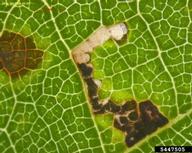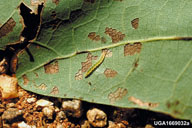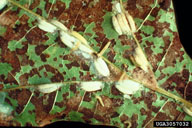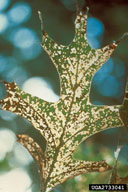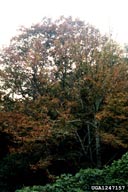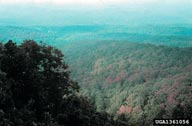Oak skeletonizer
Bucculatrix ainsliella Murtfeldt (Lepidoptera: Bucculatricidae)
Orientation to pest
The oak skeletonizer, Bucculatrix ainsliella Murtfeldt, is a native North American moth whose larvae skeletonize the leaves of some oaks (Quercus). Eggs are laid on the upper side of leaves, adjacent to a major vein. The first instar larvae are leafminers, forming a strongly contorted serpentine mine about 1 cm long. Older larvae feed externally on the lower leaf surfaces, causing "windows" in leaves or skeletonizing them. There are two generations per year. Adults are active in April and May (generation one) and again in July and August (generation two). In the southern United States fly into September. The oak skeletonizer overwinters as a pupa in a white cocoon about 3 mm in length. Occasionally outbreaks occur over large areas.
Hosts commonly attacked
Oak sekeletonizer feeds on red (Quercus rubra L.) and black (Quercus velutina Lam.) oaks. Records on chestnut oak (Quercus montana Willdenow) and chestnut (Castanea) are unconfirmed.
Distribution
The moth occurs in southern Canada and in the United States from Maine to North Carolina and west to Mississippi. It has also been introduced into British Columbia and, since 2006, into western Europe.
Images of oak skeletonizer
| Figure 1. Mine of first instar larva of oak skeletonizer | Figure 2. Oak skeletonizer larva feeding on the underside of an oak leaf | Figure 3. Oak skeletonizer cocoons attached to leaf veins; see also larvae and leaf damage (brown areas) |
| Figure 4. Leaf damage from larval feeding of oak skeletonizer | Figure 5. Damage to an oak tree due to larval feeding of oak skeletonizer | Figure 6. Damage to a stand of oak trees due to the oak skeletonizer. |
Important biological control agents related to this pest species
Pupal parasitism (either by Ichneumonidae or Chalcidoidea) reached high levels (>40% parasitism) during the first generation of a population outbreak in British Colombia (see Gelok et al. 1998), but larval parasitism was very low.
Web links for information on oak skeletonizer
- Oak Wilt Specialists Website | Scenic Hills Nursery
Fact sheet by a private nursery company - Fact Sheet | ForestPests.org | Vermont Division of Forestry
- Fact Sheet | USDA Forest Service, FHP Southern Region
- First report on its introduction into Europe | Microlepidoptera of the Netherlands
Articles
- Gelok, E., R. McGregor, D. Henderson, and L. Poirier, L. 1998. Seasonal occurrence and parasitism of Bucculatrix ainsliella (Lepidoptera: Lyonetiidae) on Quercus rubra in Burnaby, British Columbia. Journal of the Entomological Society of British Columbia 95: 111-116.
- Gibbons, C. F. and J. W. Butcher. 1961. The oak skeletonizer, Bucculatrix ainsliella, in a Michigan woodlot. Journal of Economic Entomology 54: 681-684.
